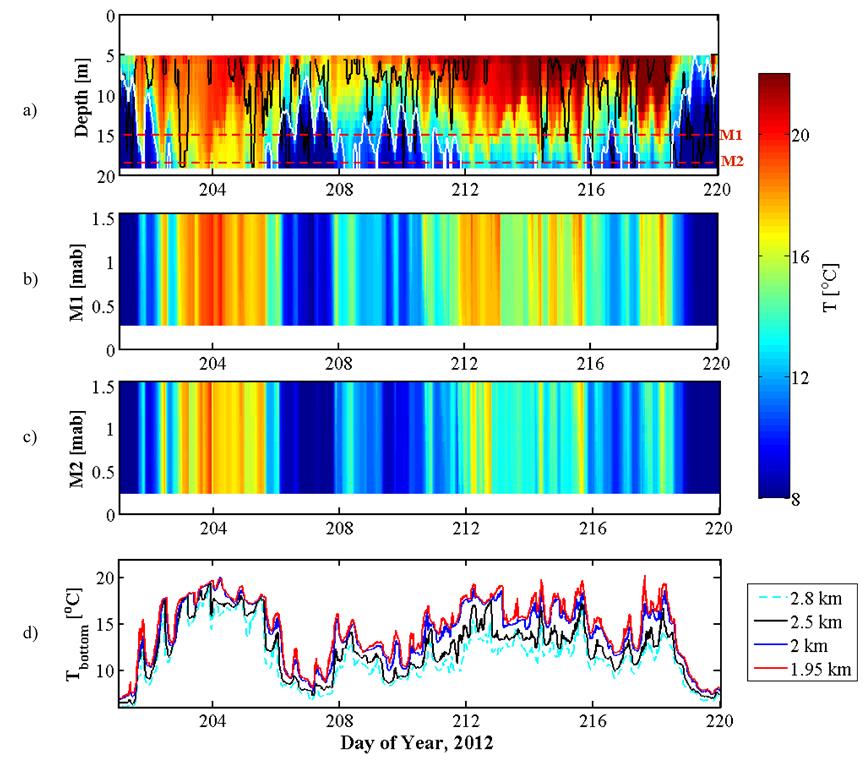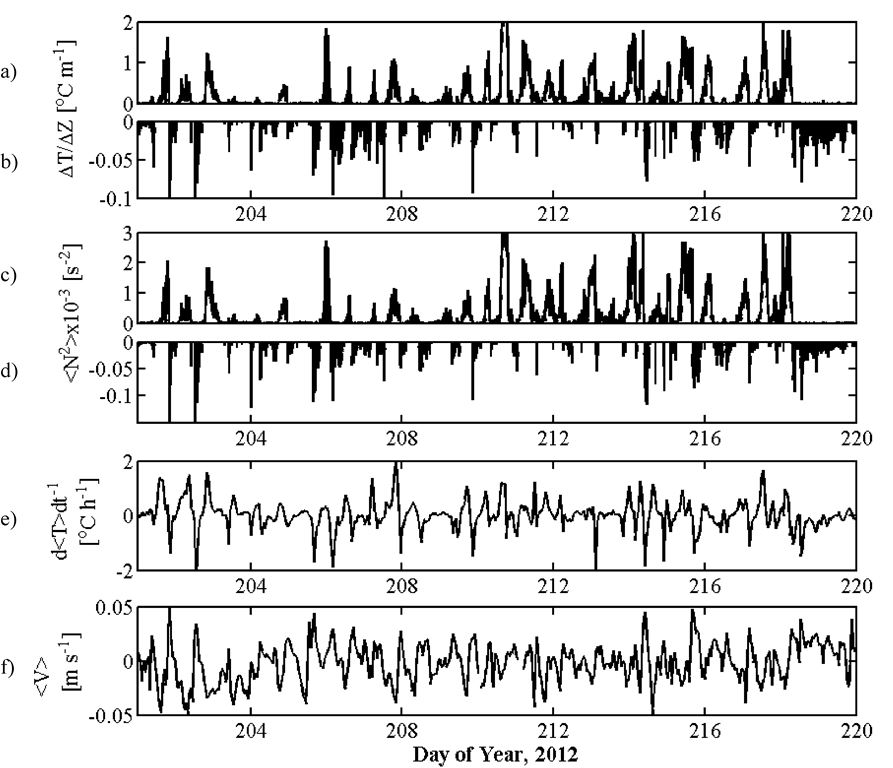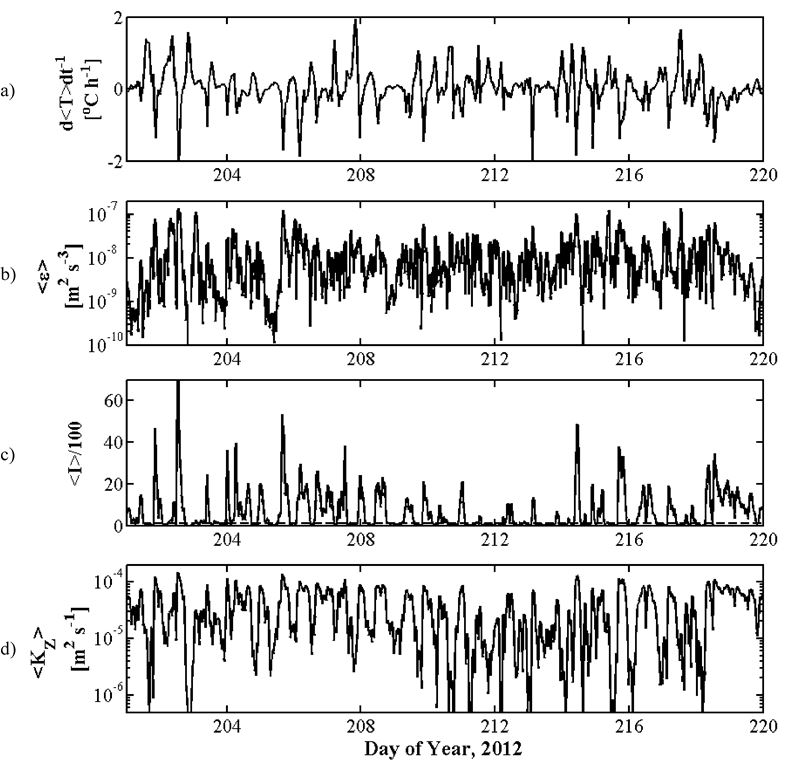| Mijanur R. Chowdhury, Ph. D.
|
|
Project Focus
Benthic boundary layer turbulence and its role in differential food supply to benthic organisms in Lake Ontario
Background and Motivation
Understanding
turbulent mixing at the bottom boundary in the nearshore of the Great Lakes is
of critical importance due to the role turbulence plays in mediating near-shore nutrient cycling
in the context of changes to the food web caused by invasive dreissenid (zebra
and quagga) mussels. The
nearshore zone of the Great Lakes extends roughly 10 km from shore and is the region where the summer thermocline
typically intersects the lakebed at depths between 15-30 m. There are always significant vertical movements of the
thermocline in all of the Great Lakes and the movements are dominated by the high amplitude near-inertial internal Poincaré waves. For an internal Poincaré wave, the maximum amplitude of the thermocline movements
occurs at the edges of the lake, whilst the maximum velocity signal associated
with Poincaré waves occur in the centre of the lakes. The ubiquitous presence of large-scale thermocline motion means that
it will impact benthic stratification and mixing dynamics everywhere
the moving thermoclien intersects with the lake bed. The main objective of the study was to examine how internal Poincaré wave-driven
thermocline movements influence nearshore benthic stratification and
mixing dynamics at the depth of the seasonal thermocline in Lake
Ontario. A secondary goal was to analyze the implications of these
processes on the context of food supply to dreissenid
mussels, nutrient supply to nuisance benthic algae (cladophora), and biotic responses at the lake
bed.
Methods
- The project was mainly based on field observations made on the northern side of Lake Ontario between 2 and 3 km from shore. Two
sets of summer observations were made, the first lasted for 20 days in
2012 and
the second lasted for 55 days in 2013. In both cases, detailed
structure of the near bed stratification was acquired at high
temporal (= 2s) and spatial resolution (=0.1m) with three benthic
thermistor chains. Water currents and surface wave data were
measured using ADCP (acoustic Doppler current profiler) units. We
also
used long-term data from the nearby water quality monitoring station –
the
Land/Ocean Biogeochemical Observatory (LOBOviz, http://ontario.loboviz.com/), operated by the Ontario Ministry of Environment and
Climate Change.
- The acquired data by the deployed
instruments were processed to analyze the offshore thermocline movement and the
associated near-bottom flow, stratification and mixing dynamics at the depth of
the thermocline by calculating a variety of parameters, including the buoyancy
frequency, depth of the thermocline, and the inferred benthic turbulent
dissipation and diffusivity caused by internal Poincaré wave-driven cross-shore flows as well as surface waves.
- Diapycnal mixing rates (Kz) caused by the thermocline movements were estimates applying the Thorpe-scale method on the measured temperature profiles by benthic temperature chains.
- surface-wave driven benthic dissipation rates was calculated from measured significant wave heights and peak wave periods.

Figure
1. Thermal stratification in water
column in (a) and near-bottom water thermal stratifications in
(b-c). Variation in near-bottom temperature in four spatial locations
is shown in (d). Positions of the
thermocline and 13oC isotherm are marked by a black and a white line respectively
in (a).
| 
Figure 2. Variability of near-bottom temperature grdient, depth-averaged buoyancy frequency and currents. | 
Figure 3. Estimated
inferred intensity of turbulence based on the Thorpe-scale method | Figure
4. Possible impact of benthic
turbulence on the food supply to mussels from deep chlorophyll maximum at the
thermocline.
|
Key Findings
- The thermocline in Lake Ontario undergoes significant vertical excursions
at near-inertial periods, indicative of strong and persistent internal Poincaré waves [Fig. 1]. The thermocline oscillation at the near-inertial internal Poincaré wave period induces a
striking asymmetry in near-bed stratification and benthic turbulence along the
sloping lakebed at the depth of the seasonal thermocline between its rise and
fall [Fig.2].
- During the falling phase of the thermocline, the warmer down-slope flows
raise the nehe near-bottom water temperature, leaving strong positively stratified near-bed waters with
temperature gradients. In
contrast during the colder up-slope flow phase, the mean near-bottom water
temperature was reduced and there was unstable stratification at the lakebed with temperature gradients.
- Due to the presence of
unstable stratification, the near bottom water of the up-slope phase
was
characterized by high incidence of temperature inversions and
relatively higher values of turbulent mixing rates. The mechanism is
identified as shear driven near-bottom convective mixing driven by large amplitude internal Poincaré waves. The
opposite occurs during the down-slope phase [Fig. 3].
- We also found that, at least
during the observation period of 2012 and 2013, benthic mixing due to
thermocline movement was much more important than that caused by the orbital
motions due to surface waves.
- We
hypothesized that the observed dynamics of benthic turbulence
may control a
differential food supply mechanism of mussels [Fig. 4]. During the rising phase of the thermocline, the
isotherms slow down at boundary and high turbulent mixing associated with
convective overturning occurs. Thus, during this phase mussels will
potentially able to filter feed more effectively experiencing possibly elevated
level of phytoplankton under mixing conditions which replenish the supply of
food near the lakebed (Fig. 4a). In contrast, during the falling phase, the
isotherms get very close together and the boundary layer is strongly stratified
and turbulence is greatly diminished. In this phase it is more likely that the
mussels’ filtration is only acting on a small distance from boundary due to the
weak mixing. Consequently, the immediate boundary becomes depleted of plankton
and the mussels are not in optimal growth conditions (Fig. 4b).
Publications
Peer-reviewed journal publicaitons:- Chowdhury,
M. R., Wells, M. G., and Howell, T., (2015).
“Movements
of thermocline lead to high
variability in benthic mixing in the nearshore of a large lake”, Water Resources Research,
AGU, under review (revise and resubmit stage).
|
|



